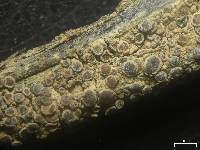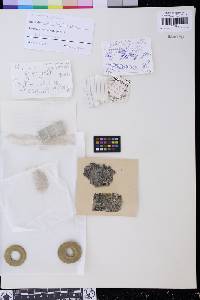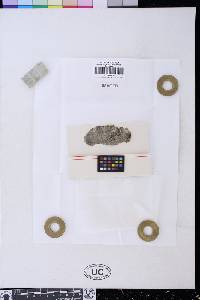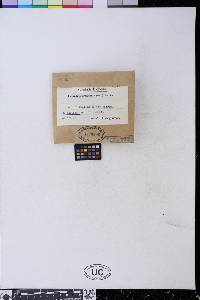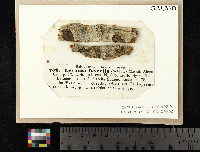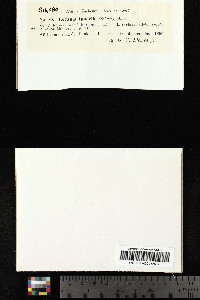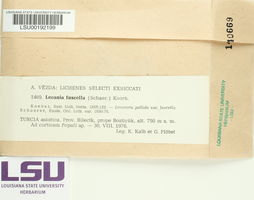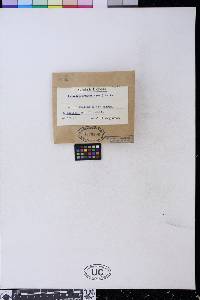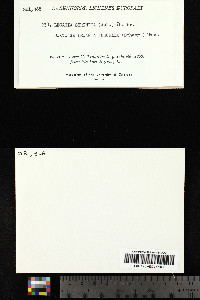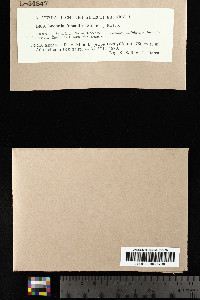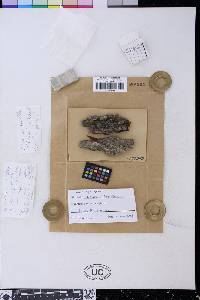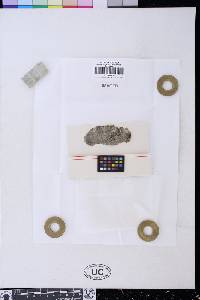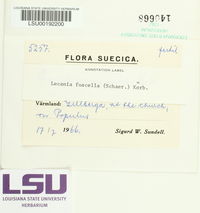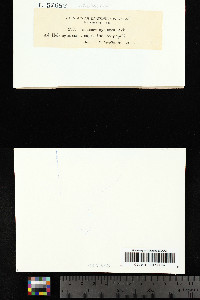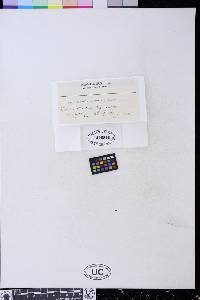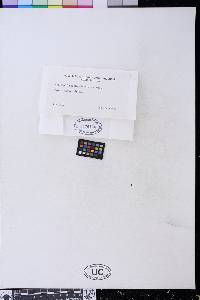
Consortium of Lichen Herbaria
- building a Global Consortium of Bryophytes and Lichens as keystones of cryptobiotic communities -
- Home
- Search
- Images
- Species Checklists
- US States: O-Z >
- US National Parks
- Central America
- South America
- US National Parks
- Southern Subpolar Region
|
|
|
|
Family: Ramalinaceae
[Lecania syringea (Ach.) Th. Fr., moreLecanora fuscella (Schaer.) A. Massal., Lecanora syringea (Ach.) Hue, Parmelia hagenii var. syringea Ach., Parmelia pallida var. fuscella Schaer., Patellaria fuscella (Schaer.) Körb.] |
Nash, T.H., Ryan, B.D., Gries, C., Bungartz, F., (eds.) 2004. Lichen Flora of the Greater Sonoran Desert Region. Vol 2. Thallus: crustose, thin areolate-granular, effuse, sometimes almost disappearing, rarely granular-scurfy, containing numerous coarse crystal clusters, up to 0.4 mm thick surface: whitish gray, sometimes slightly ochraceous, glaucous white or pale grayish brown, ±turning somewhat green when wet cortex: not developed, without an epinecral layer medulla: not developed; algal layer: filling the upper part of the thallus and reaching almost to the upper surface; algal cells: 5-12 µm in diam. Apothecia: dispersed or grouped, often crowded, sessile, constricted at base, up to 1(-1.4) mm in diam. disc: pale brown, pinkish brown, yellowish red, then becoming moderately brown to brown-black, more rarely bluish gray, paler and +dark-spotted when wet, plane to slightly convex, epruinose or thinly white or bluish gray pruinose margin: definite, at least at first, thin, c. 0.1 mm, sometimes finally almost excluded, rarely slightly pulverulent amphithecium: with an algal layer up to 70 µm thick parathecium: sometimes poorly developed, with paraplectenchymatous, conglutinated cells epihymenium: +pale to deep red-brown or brown-violet, K- or K+ purplish brown, sometimes with granules on the surface hymenium: hyaline, (45-)65-70 µm tall; paraphyses: strongly conglutinate, 2-2.5 µm wide below, simple to sometimes forked, apically +slightly swollen (35 µm wide); hypothecium hyaline, with intricate hyphae 15-30 µm thick asci: 40-50 x 12-15 µm, inflated-clavate, 8(-16)-spored ascospores: hyaline, (1-)3-septate, straight or sometimes curved, oblong, oblong-ellipsoid, fusiform-ellipsoid with abruptly rounded ends, 12-18(-22) x 4-6 µm Pycnidia: immersed, rarely found, +globose, c. 100 µm in diam., red-brown to dark-brown around the ostiole, hyaline below; ostiole: 50-60 µm wide; conidiogenous cells: elongate, sometimes branched at base, 8-10 x 2 µm conidia: filiform, moderately to strongly curved, 15-20 x 0.8 µm Spot tests: thallus K- Secondary metabolites: none detected. Substrate and ecology: on trunks or branches of trees with neutral bark and shrubs such as Acer, Fraxinus Populus, Sambucus, and Ulmus; mainly from shrubs in the Sonoran area World distribution: widely distributed in Europe, North America, and eastern Africa Sonoran distribution: only known from the Channel Islands of southern California. Notes: Lecania fuscella resembles a species of the Lecanora chlarotera group. Although this Lecania species is recorded as being rarely on rock, we never have seen any such specimens. It is characterized by its thin, inconspicuous thallus with ±plane, mostly pruinose lecanorine apothecia. Although somewhat variable in external appearance, it is most likely to be confused only with L. fuscelloides (see that species) in the Sonoran region. Care should be taken with Solenopsora cyathiformis (formerly Lecania c.), a species also with 3-septate ascospores, that differs by having larger, subpediciellate apothecia with paler discs and a thicker amphithecium, Catillaria-type asci, bacilliform conidia, and atranorin. Although L. cyrtella may very rarely have some 3-septate spores, most are 1-septate, and that species has epruinose discs and a thin, disappearing amphithecium. |
Powered by Symbiota




